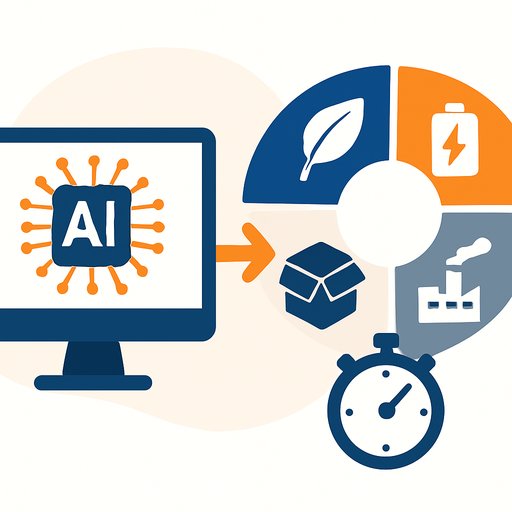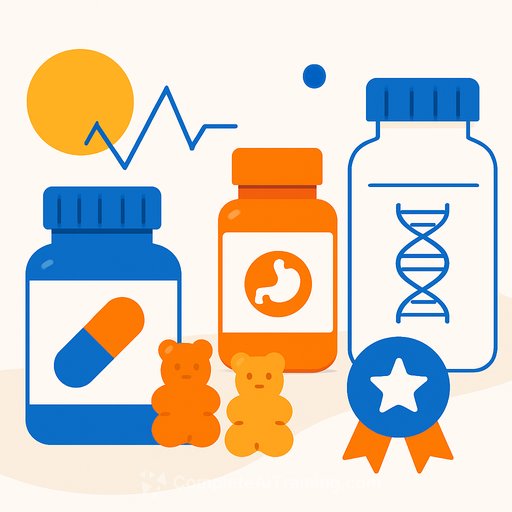AI for Faster Life Cycle Assessments: A Practical Guide for Product Teams
Sustainability shouldn't stall your roadmap. Research shows AI can compress life cycle assessment (LCA) timelines from weeks or months to days or hours-without throwing rigor out the window.
Here's a clear, usable playbook to get screening-level answers fast, iterate with confidence, and reserve deep audits for the few decisions that truly need them.
Why LCAs slow product development
- Manual data collection across materials, suppliers, manufacturing, transport, use, and end-of-life.
- Fragmented formats: PDFs, spreadsheets, ERP exports, sensor logs.
- Complex models and long simulations for each design variant.
- Supplier latency and inconsistent reporting.
Where AI helps (and how)
- Data intake and mapping: Natural language processing extracts data from BOMs, supplier PDFs, and reports; entity resolution maps materials and processes to LCA databases.
- Predictive surrogates: Trained models estimate impacts (e.g., GWP, water, energy) from a small set of inputs-ideal for early design screening.
- Automation: Scripts standardize units, fill reasonable defaults, and flag missing fields to reduce back-and-forth.
- Uncertainty and QA: Models surface confidence ranges, highlight outliers, and compare results with past verified LCAs.
A hybrid workflow that balances speed and accuracy
- 1) Ingest: Parse BOMs, supplier disclosures, test data, and public databases.
- 2) Map: Link parts and processes to reference datasets (e.g., materials, energy mix, transport modes).
- 3) Estimate: Use ML surrogates for quick impact estimates; auto-complete gaps with documented assumptions.
- 4) Validate: Compare against a set of certified LCAs; review flagged anomalies.
- 5) Escalate: For high-stakes decisions, run targeted full simulations or supplier audits.
What the research indicates
AI-accelerated assessments match conventional LCAs within acceptable error bands for many common products and materials. Edge cases-novel chemistries, unconventional processes, or sparse data-need extra scrutiny.
The takeaway: use fast AI-driven screening for design iteration and routing, and reserve detailed studies for final validation or compliance-grade reporting.
Impact for product teams
- Faster iteration: Compare design options in a sprint, not a quarter.
- Supplier choices: Run scenario analysis across vendors, regions, and transport modes.
- Early risk signals: Spot hotspots (materials, energy, packaging) before tooling or long-lead commitments.
- Access for SMEs: Get credible screening results without a large LCA budget.
Limits and cautions
- Data quality: Garbage in, garbage out-track sources, versions, and unit conversions.
- Model scope: Models trained on common products can misestimate truly novel designs.
- Transparency: Keep an assumptions log, show feature importance, and provide uncertainty ranges.
- Governance: Use human review for material decisions and compliance claims.
Implementation blueprint (90 days)
- Days 0-30: Define your target metrics (e.g., GWP, energy, water). Build a small benchmark set of 10-20 past LCAs. Stand up data intake: BOM parser, supplier document OCR/NLP, unit normalization.
- Days 31-60: Train simple surrogate models on historical data plus public references. Set acceptance thresholds (e.g., within 10-15% of benchmark for screening). Add automatic flags for missing data and outliers.
- Days 61-90: Pilot on one product line. Run weekly design reviews using AI estimates, then validate two designs with deeper analysis to calibrate. Document workflows and sign-off rules.
What to measure
- Turnaround time: Request-to-estimate hours/days.
- Coverage: Share of BOM items mapped automatically.
- Agreement: Error vs. certified LCAs on the benchmark set.
- Uncertainty: Average confidence interval width and the rate of escalations.
Suggested tool stack
- Data sources: Supplier disclosures, internal ERP/MES exports, public LCA datasets.
- Reference frameworks: ISO 14040/44, GHG Protocol Product Standard.
- Models: Gradient-boosted trees or compact neural nets for surrogates; NLP for entity extraction and material mapping.
- Ops: Versioned datasets, model cards, audit logs, and clear escalation criteria.
How to use this in your next sprint
- Pick one product and two design alternatives. Generate AI-based screening LCAs for each.
- Review hotspots with the team and swap one material or process.
- Re-run estimates, check uncertainty, and escalate only if the decision is close to a threshold.
Skill up your team
If you want structured, hands-on training for AI workflows in product and operations, explore these resources:
Bottom line
Use AI to get fast, credible estimates that guide design and supplier decisions. Keep humans in the loop, document assumptions, and validate high-impact calls with deeper studies.
Speed is an advantage. Rigor is a requirement. You can have both.
Your membership also unlocks:






